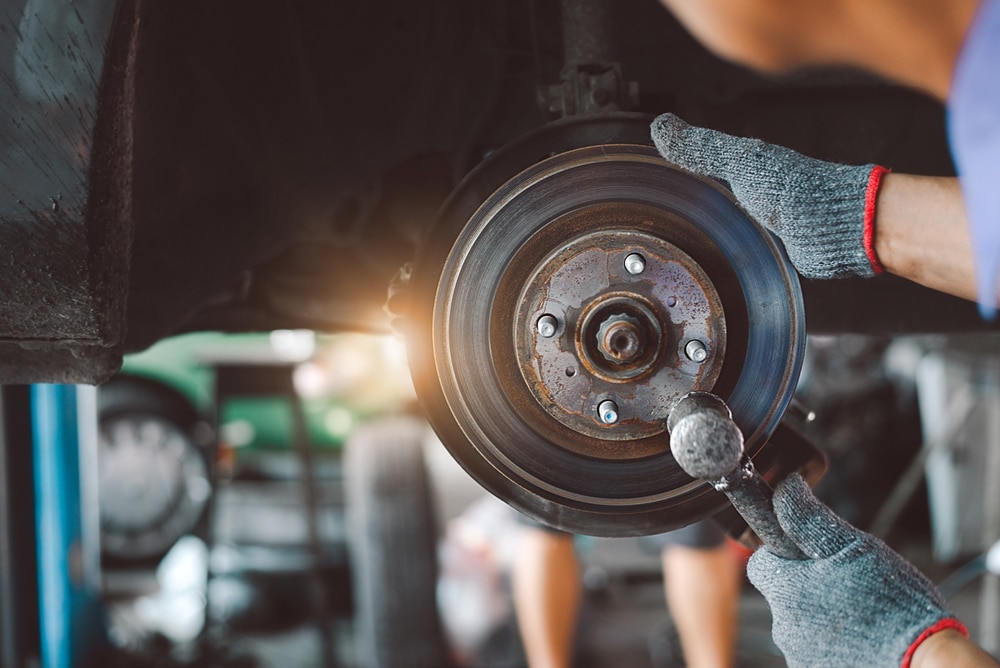Maremont Corporation was a Chicago-based automotive parts manufacturer and distributor of aftermarket automotive products. The company exposed hundreds of people to asbestos in the aftermarket friction products and exhaust products it sold from 1953 through 1978. After paying millions of dollars in asbestos claims to people diagnosed with mesothelioma and other illnesses and with thousands of claims outstanding, the company filed for Chapter 11 bankruptcy and established a $28 million trust fund.

Maremont Corporation History and Asbestos
Established in 1877 in Chicago, Illinois, Maremont Corporation was originally a manufacturer and distributor of parts for wagons, stagecoaches, and streetcars. As transportation technology changed, the company adjusted, shifted to manufacturing products for the Model T, the country’s first mass-produced vehicles. By 1940, Maremont had begun mass-producing exhaust products. It eventually became a leader in the aftermarket automotive parts industry.[1]
For more than a decade, Maremont expanded, growing internationally to South America and Europe and focusing on replacement parts and the manufacture and distribution of automotive exhaust systems, shock absorbers, MacPherson struts, and related hardware and parts. Its role in manufacturing asbestos products began in December 1953, when Maremont purchased the assets of a company known as Grizzly Manufacturing Company (“Grizzly”), located in Paulding, Ohio. Grizzly manufactured friction products, including brake linings, clutch facings, and lined brake shoes. The company began manufacturing and distributing aftermarket friction products under names besides its own. They sold mufflers that contained sealing components wrapped in asbestos and sold under the trademarked names “Maremont” and “Pratt,” as well as asbestos-containing brake linings, disc pads, and clutch facings sold under the trademarked names “Grizzly” and “Leland.” Sears, Roebuck & Company became a customer, selling asbestos brakes manufactured by Maremont under its own Craftsman brand.
Maremont Corporation’s success was significant. By acquiring numerous independent parts manufacturers, it grew to producing 8,000 parts and became the biggest independent manufacturer making a full line of products. Sales grew from $30 million in 1959 to $122 million by the late 1960s.[2]
In 1969, Maremount Corporation created a subsidiary, Maremont Exhaust Products, Maremont Exhaust Products, Inc., based in Loudon, Tennessee, which manufactured exhaust parts, including mufflers, catalytic converters, performance exhaust, pipes, and accessories, and Cherry Bomb brand mufflers established operations in Loudon, Tennessee. In 1977, Maremont sold Grizzly to Nuturn Corporation, a wholly owned subsidiary of Turner and Newell, Ltd., retaining a 20% interest for several years thereafter. Within a year of that sale, the company had stopped selling its asbestos-contaminated automotive products.[1]
In 1986, Arvin Industries, a global manufacturer of automotive components, including exhaust systems, ride control products, and lift supports, acquired Maremont, and in 2000, Arvin Industries merged into ArvinMeritor, a successor to Rockwell International, which later rebranded back to the Meritor name in 2011.
In 2006, Kenneth Banks acquired the business. In 2007, employees at the Maremont facility who were part of International Machinists Local 2545 voted to go on strike due to disputes over wages and benefits. Eight months later, the workforce ultimately decided to disband the union altogether, and the company reached its peak employment around 2011 with more than 400 workers, but the subsequent years saw a steady decline, culminating in a major crisis; the loss of a major auto parts distributor that was their largest customer.
The muffler-making facility closed, but the brand found new life when AP Exhaust Technologies Inc. of Goldsboro, North Carolina, acquired certain assets of International Muffler Co. (IMCO), including Maremont and Cherry Bomb. Until 2019, Maremont continued to operate as a non-operating subsidiary of Meritor, which owned and operated 100% of its interests.[3] At that time, facing thousands of pending lawsuits originating from its historic manufacturing and distribution of asbestos-containing products, the company formed an asbestos trust fund.
How Did Maremont Corporation Use Asbestos?
In the years between 1953 and 1978, the public was unaware of the dangers of asbestos, and Maremont Corporation incorporated the carcinogenic mineral into all of its products that were subject to high levels of heat and friction. Asbestos was both valuable for its fire and heat-resistant properties and inexpensive, making it seem perfect for automotive applications.
The company’s asbestos-containing products were largely replacement parts sold in the auto repair industry, distributed under several trade names, including:
- AVM
- Brake-In-A-Box
- Brake-King
- D.D. Silvertip
- Gabriel
- Grizzly
- Hyper
- Leland
- Load Guard
- Maremont
- Mighty-Ift
- Power-Duty
- Pratt
- S.S. Metallic
- Safety-Set
- Saftibond
- Saftigrip
- Saf-T-Stop
- Sivertip
- SteadyLift
- StrongArm
- Syncro
- The Stop Box
- Tru-Guard
- Ultra
- X-T Woven
Who Was at Risk from Maremont Corporation’s Asbestos-containing Auto Parts?
A wide range of individuals faced potential asbestos exposure from Maremont’s products—beyond the workers directly involved in manufacturing the friction and exhaust products, mechanics faced daily occupational exposure, and hobbyists who used the company’s aftermarket parts in their own cars were at risk too.
The highest risk group included factory employees who produced the asbestos-containing components from 1953 to 1978, along with automotive professionals who regularly worked with these materials and parts store workers who received the parts, managed inventory, and sold them.
The vast majority of those sickened by Maremont’s asbestos-containing products were exposed by direct occupational exposure, including:
- Auto mechanics who installed and removed Maremont brake linings, clutch facings, and mufflers
- Brake specialists who cut, ground, or sanded asbestos-containing brake components
- Muffler installers who cut muffler necks and handled asbestos-wrapped sealing components
- Factory workers at Maremont facilities where the products were manufactured
- Parts store employees who handled and distributed asbestos-containing inventory
In addition to occupational exposure, victims of exposure to Maremont’s asbestos-containing products were exposed either through secondary exposure or as hobbyists.
- Secondary exposure – Secondary asbestos exposure occurs when people are exposed to asbestos fibers brought into their home on the clothing, hair, skin, or belongings of family members or others who work directly with asbestos-containing materials. Many spouses and children of these workers, who laundered their clothing or simply hugged them and sat with them each evening when they returned home from work, have been diagnosed with asbestos-related diseases following this type of exposure.
- Shade tree mechanics – A shade tree mechanic is someone who repairs cars as a hobby or side job. The term comes from the frequency of them working outdoors under a tree for shade, in driveways, backyards, or parking lots, using basic tools as opposed to professional mechanics working in a garage. Shade tree mechanics often work on their own vehicles, help friends and neighbors, or earn extra income doing automotive repairs without the overhead of a formal shop. The more frequently they worked with asbestos-containing products, the greater their risk of being diagnosed in the future.
The Particular Dangers of Maremont’s Asbestos-containing Products
Brake linings and clutch facings are designed to wear down through friction. This means that any parts that contained asbestos constantly released deadly fibers during normal use and maintenance. The specifics involved with these repairs made the situation even more dangerous, as the work included:
- Removing worn brake components, which created clouds of dust
- Using compressed air to clean brake assemblies, which blew fibers throughout the garage
- Sanding or grinding components to fit properly
Making matters worse was the fact that most exposure occurred in enclosed garage spaces with poor ventilation.
Another reason that the company’s products had such a profound impact was their widespread distribution. Maremont products were sold through:
- Major retailers like Sears
- Independent auto parts stores
- Service stations nationwide
- Aftermarket distribution channels
This meant exposure wasn’t limited to a single facility; rather, it occurred every day, in thousands of repair shops, gas stations, and home garages across the country.
Health Risks of Asbestos Exposure
Asbestos exposure can lead to several serious diseases, many of which have long latency periods. This means that 20 to 50 years can go by between exposure and the first warning symptom.
The illnesses most frequently associated with asbestos exposure include:
- Mesothelioma – A rare, aggressive cancer that typically affects the lining of the lungs (pleura) or abdomen (peritoneum)
- Asbestos-related lung cancer – Primary lung cancer caused or contributed to by asbestos exposure
- Asbestosis – Progressive scarring of the lungs that can cause severe breathing difficulties
- Other cancers – Including colorectal, laryngeal, esophageal, pharyngeal, and stomach cancers
- Pleural disease – Non-malignant conditions affecting the lung lining
Asbestos Litigation Against Maremont Corporation
The dangers of asbestos weren’t publicized until the 1980s, but once the information became widely known, people began filing personal injury claims and wrongful death claims seeking compensation for the damages that they or their loved ones suffered. At that point, Maremont became the target of thousands of asbestos claims filed by workers, consumers, and other individuals who developed asbestos-related diseases, including mesothelioma or lung cancer.[4]
Claims Against Maremont:
- After being diagnosed with mesothelioma, Roland Grenier, Sr. filed a lawsuit against Maremont Corporation, General Motors Corporation (GM), Ford Motor Company, and others that he blamed for having exposed him to asbestos during the thirty-eight years he’d worked as an auto mechanic. The jury hearing the case found GM and Ford strictly liable. After finding GM negligent, they assigned them seventy percent responsibility, sixteen percent to Ford, and two percent each to Maremont and six other friction product manufacturers.[5]
- Daryl Middleton was employed as a mechanic at Meineke Car Care Center from 1980 to 1984 and again from late 1989 to about 1995. After he was diagnosed with lung cancer in June of 2012, he and his wife, Belinda, filed a lawsuit against Maremont seeking compensation for injuries caused by his exposure to the company’s asbestos-containing products. His testimony included detailed descriptions of his work installing and removing asbestos-containing engine pipes, mufflers, and brakes, dismantling old mufflers, and cutting new mufflers’ necks while fitting them. He also said that he was exposed to asbestos as a result of cutting engine pipes and sanding brakes. Though the company filed a motion to dismiss his claim, its motion was denied.[6]
Maremont Corporation Asbestos Personal Injury Trust
Thousands of auto mechanics and hobbyists sickened by Maremont’s asbestos-containing products filed suit against the company, and over the years, the company paid roughly $52 million in settlements and jury verdicts. With over 1,900 asbestos-related legal cases still pending, Maremont filed for Chapter 11 bankruptcy in 2019 and established The Maremont Personal Injury Asbestos Trust.
The trust was funded with $28 million in cash, with an additional $20 million loan receivable from its parent company, Meritor Inc., structuring the fund’s value to be up to approximately $50 million in cash. These monies are set aside to compensate current and future victims of asbestos exposure, and have the potential of reaching $65 million, according to court records.[4]
The trust provides compensation based on disease severity and exposure criteria. The expedited review payments are as follows:[7]
- Mesothelioma (Occupational Claims) – $111,500
- Mesothelioma (Shade Tree Mechanic Claims) – $12,100
- Lung Cancer – $25,400
- Other Cancer – $5,400
- Severe Asbestosis – $25,400
The company pays claims based on established criteria that distinguish between occupational exposure claims and those filed by individual auto enthusiasts or those sickened through secondary exposure. Claims must meet specific medical and exposure criteria to be eligible for compensation from the trust.
What to Do if You Were Exposed to Asbestos from Maremont Corporation Products
Being diagnosed with malignant mesothelioma, asbestos-related lung cancer, asbestosis, or any other asbestos-related disease is a life-changing and traumatic event. Because of the long latency period between asbestos exposure and the appearance of symptoms, as well as the fact that those sickened by asbestos generally were exposed to products manufactured or supplied by multiple companies, many victims need help identifying the source or sources of their exposure to the toxic material, as well as guidance on how best to move forward.
The best place to get the information you need is by contacting an experienced asbestos attorney. These compassionate professionals specialize in helping those diagnosed with mesothelioma and other asbestos-related diseases. They have deep knowledge of negligence and product liability laws, the impact of asbestos exposure, and the outcomes achieved by victims in situations similar to yours.
Asbestos law firms have extensive resources to help match your occupational history to the various job sites that have been identified as being contaminated and the products that were present in those environments. They will listen carefully, answer all your questions, and provide you with thoughtful insights into the various options available to you, including filing a claim with the Maremont Corporation Asbestos Personal Injury Trust and whether you are eligible to file a trust fund claim or personal injury lawsuit against any other companies. Their goal is to help you get the compensation you deserve in the way that best suits you and your family.
References
- LinkedIn. (N.D.). International Muffler Company/Maremont
Retrieved from: https://www.linkedin.com/company/international-muffler-company-maremont/ - Time Magazine. (N.D.). March 20, 1964. Corporations: A Man of Many Parts
Retrieved from: https://time.com/archive/6873489/corporations-a-man-of-many-parts/ - Knox News. (September 13, 2013.) Maremont Exhaust Products closing, 150 jobs lost
Retrieved from: https://archive.knoxnews.com/business/maremont-exhaust-products-closing-150-jobs-lost-ep-510404649-355478251.html/ - The BRAKE Report. (January 23, 2019.) Meritor Continues with Plan to Resolve Asbestos Liabilities
Retrieved from: https://thebrakereport.com/meritor-continues-with-plan-to-resolve-asbestos-liabilities/ - Findlaw (N.D.). GENERAL MOTORS CORPORATION v. GRENIER (2009)
Retrieved from: https://caselaw.findlaw.com/court/de-supreme-court/1417729.html - Casemine. (N.D.). Middleton v. AmChem Prods. Inc.
Retrieved from: https://www.casemine.com/judgement/us/5c37c95e342cca32140421df/amp - Maremont Asbestos Personal Injury Trust. (N.D.). Maremont Asbestos Personal Injury Trust.
Retrieved from: http://maremont.mfrclaims.com

Terri Heimann Oppenheimer
WriterTerri Oppenheimer has been writing about mesothelioma and asbestos topics for over ten years. She has a degree in English from the College of William and Mary. Terri’s experience as the head writer of our Mesothelioma.net news blog gives her a wealth of knowledge which she brings to all Mesothelioma.net articles she authors.

Dave Foster
Page EditorDave has been a mesothelioma Patient Advocate for over 10 years. He consistently attends all major national and international mesothelioma meetings. In doing so, he is able to stay on top of the latest treatments, clinical trials, and research results. He also personally meets with mesothelioma patients and their families and connects them with the best medical specialists and legal representatives available.


